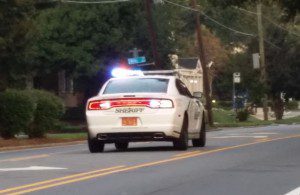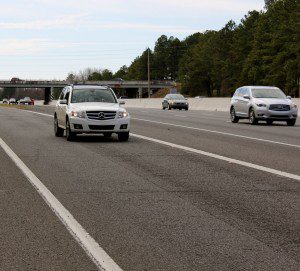North Carolina Speeding Laws Explained 
Everyone knows it is against the law to operate your vehicle at a speed greater than the posted limit. We also understand that we must adjust our speed to account for changing road conditions and weather. But what you may not know is exactly how the speeding law was written. The language used by our legislature can provide the basis for legal challenges and offer options in certain situations. In North Carolina, speeding tickets are the most common citation written. In the Charlotte, NC area, including Lake Norman, Huntersville, Cornelius, and Pineville, it is reported that over 1000 tickets are written every day.
For those clients who want to read what the law actually prohibits, we have included a paraphrased version of the statute here in relevant part. We have also provided what we believe is clarifying commentary without all of the legalese. For more specific questions, we would encourage you to call our office (704-334-7897) and speak with Charlotte traffic ticket attorney Anthony Wayne (704-960-9097 mobile).
§ 20-141. Speed restrictions.
(a) No person shall drive a vehicle at a speed greater than is reasonable and prudent under the conditions then existing (use your common sense and good judgement – adjust your speed to fit the situation)
(b) Unless provided otherwise, it shall be unlawful to operate a vehicle in excess of the following speeds:
(1) Thirty-five (35) miles per hour inside (cities and towns) for all vehicles.
(2) Fifty-five (55) miles per hour outside (cities and towns) for all vehicles except for school buses and school activity buses.
(c) Unless you are towing another vehicle, or when an advisory safe-speed sign indicates a slower speed, it shall be unlawful to operate a passenger vehicle  upon the interstate and primary highway system at less than the following speeds:
upon the interstate and primary highway system at less than the following speeds:
(1) Forty (40) miles per hour in a speed zone of 55 miles per hour.
(2) Forty-five (45) miles per hour in a speed zone of 60 miles per hour or greater.
These minimum speeds shall be enforceable only when appropriate signs are posted indicating the minimum speed.
(d) (1) The Department of Transportation shall determine and declare a reasonable and safe speed limit based on the results of an engineering and traffic investigation study.
(2) A speed limit set pursuant to this subsection may not exceed 70 miles per hour.
Speed limits set are not effective until appropriate signs giving notice are erected upon the parts of the highway affected.
(e) Local authorities, in their respective jurisdictions, may authorize by ordinance higher speeds or lower speeds upon all streets which are not part of the State highway system. But, no speed so fixed shall authorize a speed in excess of 55 miles per hour, and speed limits shall become effective after appropriate signs giving notice are erected upon the part of the streets affected.
(e)(1) A person who drives a motor vehicle on school property at a speed greater than the speed limit set and posted is responsible for an infraction and will pay a penalty of two hundred fifty dollars ($250.00).
(h) No person shall operate a motor vehicle on the highway at such a slow speed as to impede the normal and reasonable movement of traffic except when reduced speed is necessary for safe operation. This provision shall not apply to farm tractors or other motor vehicles operating at reasonable speeds for their type of vehicles.
(j1) A person who drives a vehicle on a highway at a speed that is either more than 15 miles per hour more than the speed limit established by law for the  highway where the offense occurred or over 80 miles per hour is guilty of a Class 3 misdemeanor (Going 15 mph over a posted speed limit is easy to do if you are not paying close attention to posted speed limits on the road. But operating a vehicle in excess of 80 mph is simply indefensible unless done in response to an emergency.)
highway where the offense occurred or over 80 miles per hour is guilty of a Class 3 misdemeanor (Going 15 mph over a posted speed limit is easy to do if you are not paying close attention to posted speed limits on the road. But operating a vehicle in excess of 80 mph is simply indefensible unless done in response to an emergency.)
(j2) A person who drives a motor vehicle in a highway work zone at a speed greater than the speed limit set and posted under this section shall be required to pay a penalty of two hundred fifty dollars ($250.00). This penalty shall be imposed in addition to those penalties established in this Chapter. A “highway work zone” is the area between the first sign indicating a work zone and the last sign showing the end of the work zone. The additional penalty imposed applies only if signs are posted at the beginning and end of any segment of the highway work zone stating the penalty for speeding in that segment of the work zone. (Here is the defense provided. If charged with this traffic offense, you need to go back and see if signs with the additional penalty are posted and clearly vehicle. A simple photograph can save you $250.00. Also note any vehicle speed greater than that posted is enough. There is no “grace speed” under this law.)
A law enforcement officer issuing a citation for a violation while in a highway work zone shall indicate the vehicle speed and speed limit posted in the segment of the work zone. (Here is another potential defense if your traffic ticket does not comply with this provision and requirement) 
(j3) A person is guilty of a Class 2 misdemeanor if the person drives a commercial motor vehicle carrying a load that is subject to permit upon a highway at a speed of 15 miles per hour or more above either:
(1) The posted speed; or
(2) The restricted speed, if any, that would be applicable to the load whether or not a permit is obtained.
(m) The fact that the speed of a vehicle is lower than the posted limit shall not relieve the operator of a vehicle from the duty to decrease speed as may be necessary to avoid colliding with any person or vehicle on the highway, and to avoid injury to any person or property. (Another provision requiring the use of common sense by drivers to adjust their speed to road conditions. Rarely cited for speeding, drivers in this situation are usually charged with failure to reduce speed or too fast for conditions)
(o) A violation of G.S. 20-123.2 shall be a lesser included offense in any violation of this section, and shall be subject to the following limitations and conditions:
(1) A violation of G.S. 20-123.2 shall be recorded in the driver’s official record as “Improper equipment – Speedometer.” (This is the most sought after option for those individuals charged with a speeding infraction. There are currently no limits on how many IE reductions one can have. However, Assistant District Attorneys are reluctant to grant such reduction unless the driver has a good driving record over the past three (3) years. And now, improper equipment will show up on your driving record so multiple reductions can be seen by ADAs)
(2) The lesser included offense shall not apply to charges of speeding in excess of 25 miles per hour or more over the posted speed limit. (This prohibition applies regardless of the driver’s prior record. Their record can be spotless, but an IE would still not be available for this excessive speed)
No drivers license points or insurance surcharge shall be assessed for a violation of this subsection. (This is why everyone wants this option if they can get it)
(p) A driver charged with speeding in excess of 25 miles per hour over the posted speed limit shall be ineligible for a prayer for judgment continued. (As with IE, you cannot get a judge to grant a PJC if excessive speed is involved. If allowed, a District Court Judge may continue any judgment with no finding of guilt entered into the Court record. You will still be responsible for Court costs but no fine as you have not been convicted of any charge. Only a Judge can grant a PJC, and the District Attorney can either recommend, take no position, or oppose a PJC request once you appear before the Court. You are allowed one (1) PJC every three (3) years per insurance policy, as far as insurance points are concerned. So, use this option sparingly to avoid rate increases. And finally, a PJC is not available for DWI charges and may not be granted if requested after you have already plead guilty. So be sure that you get one before simply pleading guilty; its too late after that point.)
As you can now see after reviewing the actual law, NC speeding tickets can be tricky unless you know what you are doing. Fortunately, North Carolina law gives more options than some other states. In South Carolina, for example, the only “reduction” available is “9 mph over the posted speed limit.” In many cases, the officer or trooper will reduce a ticket at the street but will circle the actual speed if the driver later decides to contest the infraction. In our State, there are several important alternatives that may allow you to avoid driver’s license points and insurance rate increases. Of course, the best outcome of all is a complete dismissal of the charge with no fine or court costs at all. Before you decide how to handle a NC speeding ticket, call us to see what we can do to help.
